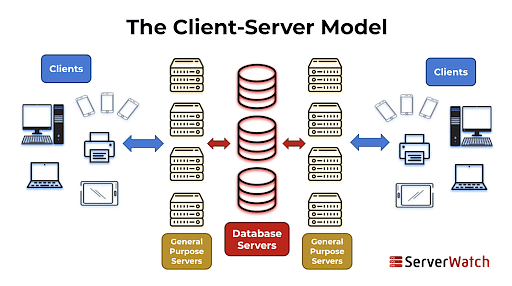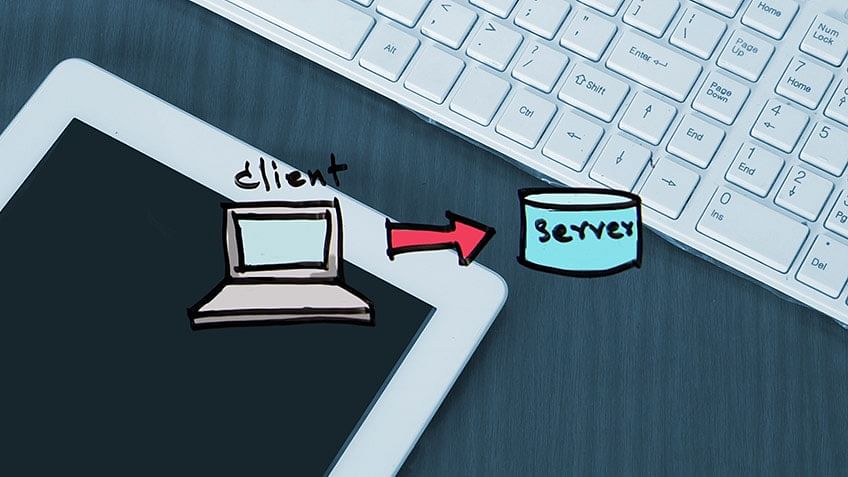Client-server architecture is a computer network design where multiple clients request and receive services from a centralized server.
More people than ever use computers today and rely on these devices and the networks they’re attached to for many tasks, from the critical to the frivolous. Unsurprisingly, the sheer volume of users and the even more significant number of requests strain servers and networks.
As if these challenges aren’t enough, IT professionals must deal with a constant stream of new technology that must be implemented into the network. Evolving in this fast-paced landscape is critical for keeping an organization up to date and competitive.Simply put, there is no alternative.
IT professionals handle this strain by implementing client and server architecture — or client-server architecture. But you may be wondering, “What is a client-server network?” Well, you’ve come to the right place. This article will explain client-server architecture, show you a client-server model, and illustrate the advantages of client-server architecture.
Let’s look at some fundamentals first, then get to the heart of the matter.
Terminology Basics
A Client is either a person or an organization using as a service. In the IT context, the client is a computer/device, also called a Host, that actually uses the service or accepts the information. Client devices include laptops, workstations, IoT devices, and similar network-friendly devices.
A Server in the IT world is a remote computer that provides access to data and services. Servers are usually physical devices such as rack servers, though the rise of cloud computing has brought virtual servers into the equation. The server handles processes like e-mail, application hosting, Internet connections, printing, and more.
Client-Server Architecture Explained
The client-server architecture refers to a system that hosts, delivers, and manages most of the resources and services that the client requests. In this model, all requests and services are delivered over a network, and it is also referred to as the networking computing model or client server network.
Client-server architecture, alternatively called a client-server model, is a network application that breaks down tasks and workloads between clients and servers that reside on the same system or are linked by a computer network.
Client-server architecture typically features multiple users’ workstations, PCs, or other devices, connected to a central server via an Internet connection or other network. The client sends a request for data, and the server accepts and accommodates the request, sending the data packets back to the user who needs them.
This model is also called a client-server network or a network computing model.
To sum it up briefly:
- First, the client sends their request via a network-enabled device
- Then, the network server accepts and processes the user request
- Finally, the server delivers the reply to the client
What’s the Purpose of Client-Server Architecture?
We have already established that technology is constantly evolving and improving, often at a very rapid pace. As a result, today’s businesses increasingly rely on technology, especially IT, to flourish and stay competitive in an “evolve or die” environment.
Therefore, today’s organizations need a system that makes it easy to collect, process, and act on corporate data, thus increasing business procedure efficiency and ensuring survivability in the modern world’s markets.
The client-server network model brings a higher level of processing that increases the effectiveness of workstation power, workgroup empowerment, remote network management, market-driven business, and the preservation of existing investments.
In summary, client-server architecture provides the exact framework that today’s organizations need to meet the challenges of a rapidly evolving IT world.
The Characteristics of Client-Server Architecture
Client-server architecture typically features the following characteristics:
- Client and server machines typically require different hardware and software resources and come from other vendors.
- The network has horizontal scalability, which increases the number of client machines and vertical scalability, an then moves the entire process to more powerful servers or a multi-server configuration.
- One computer server can provide multiple services simultaneously, although each service requires a separate server program.
- Both client and server applications interact directly with a transport layer protocol. This process establishes communication and enables the entities to send and receive information.
- Both the client and server computers need a complete stack of protocols. The transport protocol employs lower-layer protocols to send and receive individual messages.
Visualizing Client-Server Architecture
The following client-server diagram shows the basics of of the architecture:

Source: Serverwatch.
What Are Some Examples of Client-Server Architecture?
You may wonder what constitutes a real-life application of client-server architecture. Here are three examples of how you use client-server architecture, probably more often than you think!
- Email servers: Thanks to ease and speed, e-mail has supplanted traditional postal mail as the primary form of corporate communication. E-mail servers, aided by various brands of dedicated software, send and receive e-mails between parties.
- File servers: If you store files on cloud-based services such as Google Docs or Microsoft Office, you’re using a file server. File servers are centralized locations for file storage and are accessed by many clients.
- Web servers: These high-performance servers host many different websites, and clients access them through the Internet. Here’s a step-by-step breakdown:
- The client/user uses their web browser to enter the URL they want
- The browser asks the Domain Name System (DNS) for an IP address
- The DNS server finds the desired server’s IP address and sends it to the web browser
- The browser creates either an HTTPS or HTTP request
- The server/producer sends the user the correct files
- The client/user receives the files sent by the server, and the process is repeated as needed
The Advantages and Disadvantages of Client-Server Architecture
Client-server architecture brings its share of positives and negatives to today’s digital consumers. We start with a list of advantages:
- It’s a centralized system that keeps all the data and its controls in one place
- It brings a high level of scalability, organization, and efficiency
- It allows the IT staff to change the Client and Server capacities separately
- It’s cost-efficient, especially in terms of maintenance
- It allows data recovery
- It allows load-balancing, which optimizes performance
- It allows different platforms to share resources
- Users don’t need to log into a terminal or another processor to access corporate information or desktop tools like PowerPoint presenters or spreadsheet utilities
- The setup reduces the incidence of data replication
Naturally, client-server architecture isn’t all sunshine and lollipops. Here are the downsides:
- If the server has a worm, virus, or Trojan, the users will likely catch it since the network consists of linked clients and servers
- The server is vulnerable to Denial of Service (DoS) attacks
- Data packets can be spoofed or modified during transmission
- It’s expensive to start up and initially implement
- If a critical server goes down, the clients are dead in the water
- The setup is prone to phishing and Man in the Middle (MITM) attacks
What’s 3-Tier Client-Server Architecture?
The three-tier client-server architecture consists of a presentation tier known as the User Interface layer, an application tier called the Service layer, and a data tier comprising the database server. Three-tier architecture can be divided into three parts:
- Presentation layer (or Client Tier): This layer takes care of the User Interface.
- Application layer (or Business Tier): This layer handles the detailed processing.
- Database layer (or Data Tier): This layer stores the information.
The Client system controls the Presentation layer; the Application server looks after the Application layer, and the Server system supervises the Database layer.
Here’s a model of 3-Tier client-server architecture:

Source: Thecrazyprogrammer
Client-Server vs. Peer-to-Peer: A Comparison
Peer-to-peer networks, also called P2P networks, consist of groups of computers (also called nodes or peers) linked together in a network, where peers act as both a client and a server. Peers have equal responsibilities and permissions to work with data. This setup radically differs from the client-server model, which has very defined groups of users and servers.
If you walked into a fast-food restaurant, went to the counter, and ordered a burger from the counter person, that would be a client-server relationship. However, if you entered that establishment the following day and found that they had removed the staff, you could yell, “Someone, please get me a burger!” and another customer would get up, get you a burger, and ring up the sale. That’s a peer-to-peer network!
If you’ve heard of blockchain, congratulations, you’re aware of a peer-to-peer network!
Here are the main differences between the two network models:
- Client-server networks need a central file server and consequently cost more to implement; peer-to-peer doesn’t have that server.
- Client-server networks delineate between users and providers; peers act as both consumers and providers.
- Client-server networks offer more levels of security, making them safer. The end-users are responsible for peer-to-peer network security.
- The more active nodes in a peer-to-peer network, the more its performance suffers. Client-server networks offer better stability and scalability. The ideal range for P2P networks is two to eight users.
- Peer-to-peer users can share files faster and easier than on a client-server network.
- If a client-server network server crashes, everything comes to a halt, but if a single node in a P2P network fails, the rest remains operational.
Making Sense of the IT World
The fast-paced world of Information Technology is constantly evolving and changing. And it’s not just businesses and organizations that need to keep up — IT professionals who want to stay ahead of the pack and improve their chances to be hired or advance in their company must expand and enhance their technological proficiency.
Fortunately, Simplilearn has all the resources you need to upskill and improve your marketability to a prospective company. Whether it’s IT Service and Architecture, Artificial Intelligence and Machine Learning, Cyber Security, or many other fields, Simplilearn has the programs, bootcamps, tutorials, and other resources you need to become an IT authority.
Check out Simplilearn today and take your career to the next level!
